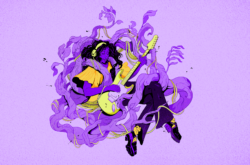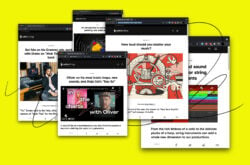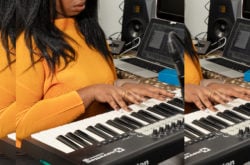Illustration: Simone Noronha
Are the songs you’re producing feeling a little stale?
It happens to the best of us—we fall into a comfortable routine, settle for what we’re already good at, and forget to challenge ourselves. While this is okay for a little while, over time it can cause you to feel creatively drained, unmotivated, and uninspired with your music production process.
That’s why it’s important to switch things up every now and then—learn a new skill, try something different, and challenge yourself in ways you haven’t before. Whether you’re new at producing or you’re a seasoned pro, there’s always something new to discover when you step out of your comfort zone.
Read on to discover 12 music production challenges you can try next time you sit down to produce. These will not only help you test and improve your skills, but will get you inspired and excited to make music.
Let’s take a look!
1. Recreate a song as closely as possible
“Imitation is the sincerest form of flattery.” It’s also one of the best ways to learn from those who you admire and look up to.
Pick a song that you really like and see how precisely you can recreate it. Use active listening to break it down into parts, listening for every instrument, effect, and even automation.
Of course, you won’t be able to make the song sound 100% like the original, but you’ll learn a lot in the process and discover new techniques you can use in your own music. You might find yourself coming up with “hacks” to create the same sound as the original producer without their tools and plugins—this is perfectly fine and can even help you find your own unique way of doing things.
2. Play around with genres
If you have a go-to genre or style that you’ve mastered, that’s great, but there’s so much you can learn from other genres, too. Chances are, you already listen to music in a few different genres. If you don’t already, make an effort to listen carefully for what exactly makes them unique so you can try these elements in your own music production process.
To start, try recreating a song you like in a different genre. The challenge is keeping the melody the same, while changing the arrangement, embellishments, and production to give the song a different feel.
Once you feel like you’re comfortable producing in a few different genres, why not try making a song that combines two of them? The more unlikely they are to go together, the better—you may even end up finding your own signature sound!
3. Produce a song using recorded sounds (but no instruments)
Music production doesn’t have to be limited to using instruments and samples. Our world is filled with all kinds of sounds, and many of them can make a pretty good substitute for your bass guitar or drum kit.
Get yourself a portable microphone (or just use your phone), and record the sounds around you. These can be sounds made with household items like dishes, paper, elastic bands—anything you can get your hands on. Then, spend some time cleaning up the sounds, pitching them, and adding effects, so that you can use them in your production.
Don’t forget that you can use your voice and your body as instruments, too—singing vocables, humming, clearing your throat, breathing, clapping, snapping, or tapping your chest all count!
4. Produce an entire song using only Splice Sounds
What about producing a song without recording anything at all? No instruments, no MIDI tracks—just the loops and one-shots you find on Splice.
Feel free to change the pitch or tempo of the sounds you find to speed up the process, but try to avoid simply using sounds from a single pack—that’s just too easy! You can also try using Create to find sounds that work together—this method will also adjust the pitch and tempo of different loops for you.
As you’re browsing through sounds, you may even find a sample that completely changes the direction of your song. Sometimes, the best ideas come when you come across something you didn’t know you were looking for.
5. Produce a song with five tracks or less
It’s easy to produce a great sounding song when there’s no limit to how many instruments and layers you can add. But can you do it with just five tracks?
When you can’t distract the listener with cool layers and fancy effects, you’ll need to impress them with just the bare bones, meaning you’ll need strong melodies, chords, and percussive elements. You’ll have to really prioritize the space you have and make sure every single sound is there for a reason.
Some of the world’s best songs are very minimal in their production, so you never know—you may just create your next hit!
6. Produce a full song in under one hour
Producing a song obviously takes much longer than an hour, but creating this time limit for yourself can help you practice trusting your intuition and making decisions quickly.
Far too often, we get plagued by our own perfectionism and spend way too much time tweaking something that, in the grand scheme of things, doesn’t make or break the song. This can often lead to lost motivation and dozens of unfinished projects.
If you’re someone who struggles with perfectionism or finishing songs, try giving yourself just one hour to produce a full song. You’ll be surprised at how quickly you can work when you trust your gut and don’t stop to question every single one of your decisions.
7. Produce a song for a different time period
Chances are, you’re probably trying to produce something that would sound great on the radio today, but what about producing something that sounds like it could’ve been released in another decade? Just because popular music has changed over the years, that doesn’t mean there isn’t anything to learn from those who came before us.
Take this idea a little further and try producing something that could be popular in 2040. Of course, it’s impossible to know what that sounds like, but it might be fun to try anyway. Plus, creating something that sounds like “music of the future” is exactly how new trends emerge.
8. Produce a song for a movie scene
Movies offer a wealth of inspiration for us musicians. Simply take one of your favorite movies, pick a scene or a montage, and watch it without sound (but keep the subtitles on if there’s dialogue so you know what they’re saying).
Imagine you’re in charge of composing the score for this scene or producing a song that would play in the background. Can you create music that would help elevate the emotions in the scene and deepen the audience’s reaction to it?
You never know, this may just be the start of a project that ends up getting a sync placement!
9. Produce a song in a time signature or tempo you’ve never worked with before
With each new song you produce, there are plenty of opportunities to get creative with melodies, chord progressions, instruments, and arrangement. But, one thing that tends to stay the same is the time signature, and sometimes even the tempo. It’s far too easy to get comfortable producing songs in 4/4 that are around 120 BPM without giving it much thought.
To challenge yourself, try producing a song in 3/4 or 5/4, for example, or any other time signature that’s not common for you. If you’re always producing songs that are similar in tempo, try slowing it down or speeding it up. Slow and fast songs require completely different approaches, so you’re guaranteed to learn something new in the process.
10. Try working backwards
Having a regular process around music production is really handy and can save you a lot of time. But, it’s also nice to switch things up every now and then. If there’s a certain order in which you do things—for example, chords, then melody, then drums—try doing the opposite of what you’re used to. It may seem awkward at first, but you’ll be pleasantly surprised with what you end up creating.
11. Try live looping
Live looping is a fun, fast-paced way to make music on the spot. Much like setting a one-hour time limit, it forces you to get creative in the moment, without striving for perfection or judging what you come up with.
You don’t need any special equipment to try looping—most DAWs support looping plugins and let you program a keyboard shortcut to trigger the loop.
12. Turn off your sound and produce a song without hearing it
If you’ve been producing for a while, you probably have enough experience and knowledge to tell how something might sound just by looking at it in your DAW. Why not test this theory and try producing something without hearing it? Turn off your speakers and see how accurately you can translate what you hear in your head into music.
You’ll probably need to tweak it a bit (or a lot) after, but it’s a fun experiment nonetheless. You might even unintentionally create something you weren’t expecting!
Are there any fun music production challenges that we missed? Will you be trying any of these out for yourself? Be sure to share your thoughts with us via the Splice Discord—we’d love to know how it turns out!
Find inspiration with our new sample discovery feature:
January 11, 2024



